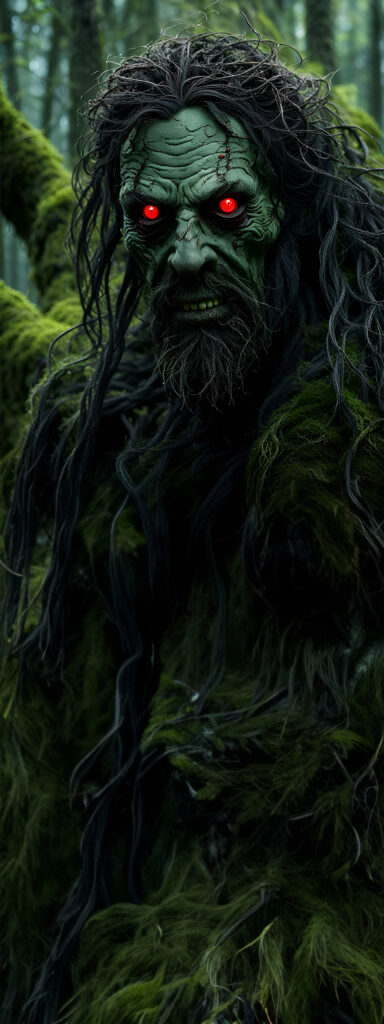Frequency: Rare
No. Appearing: 1-4 (1d4)
Armor Class: 5
Move: 20’, swimming 30’
Hit Dice: 5d8 (23 hp)
% In Lair: 95%
Treasure Type: G
Attacks: 2 (2 claws or 1 claw and 1 bite)
Damage: 1d6 Claw / 1d6 Claw / 1d8 Bite
Special Attacks: See Below
Special Defenses: See Below
Magic Resistance: Standard
Intelligence: Average
Alignment: Chaotic Evil
Size: M
Psionic Ability: Nil
Level/ X.P. Value: V / 150 + 6 per HP
 Fuath are malevolent creatures that inhabit swamps and bogs, appearing as dark, shadowy figures with glowing red eyes, empty pits for a nose, and sharp, pointed teeth that exude menace and malice. Their long, tangled hair and scraggly beards are often covered in moss, blending seamlessly with the murky and wet environment of their swampy domains.
Fuath are malevolent creatures that inhabit swamps and bogs, appearing as dark, shadowy figures with glowing red eyes, empty pits for a nose, and sharp, pointed teeth that exude menace and malice. Their long, tangled hair and scraggly beards are often covered in moss, blending seamlessly with the murky and wet environment of their swampy domains.As guardians of their watery territories, Fuath have a deep animosity towards humans and other intruders, attacking and causing harm to those who venture into their domain. They are adept at shapechanging, able to transform into an alligator or giant frog at will, allowing them to move and hunt stealthily through the waters of their swamp habitats.
Some Fuath have formed an unusual bond with a rare and deadly creature known as a Swampstalker, keeping it as a pet and fierce companion in their swampy realms. When a Fuath forms a bond with a Swampstalker, they forge a formidable partnership, combining the Fuath’s cunning and malevolence with the Swampstalker’s ferocity and predatory instincts.
Encountering a Fuath is a chilling and dangerous experience, as their malevolent nature and protective instincts make them formidable adversaries. Adventurers who delve into the dark and treacherous swamps must beware the lurking presence of Fuath, who will stop at nothing to defend their territory and ward off any who dare to trespass into their domain.
Special Abilities:
- Shadowy Shapechanger: Fuath can transform into an alligator or giant frog at will, enabling them to navigate and hunt in their swampy habitats with ease and stealth.
- Malevolent Guardian: Fuath are dark, shadowy figures with glowing red eyes, sharp teeth, and a particular disdain for humans. They protect their swamps and bogs fiercely, attacking intruders and causing harm to those who cross their path.
- Swamp Dweller: Fuath dwell in swamps and bogs, blending into the dark and murky waters with their scraggly beards, tangled hair, and moss-covered forms, making them difficult to spot until it’s too late.
